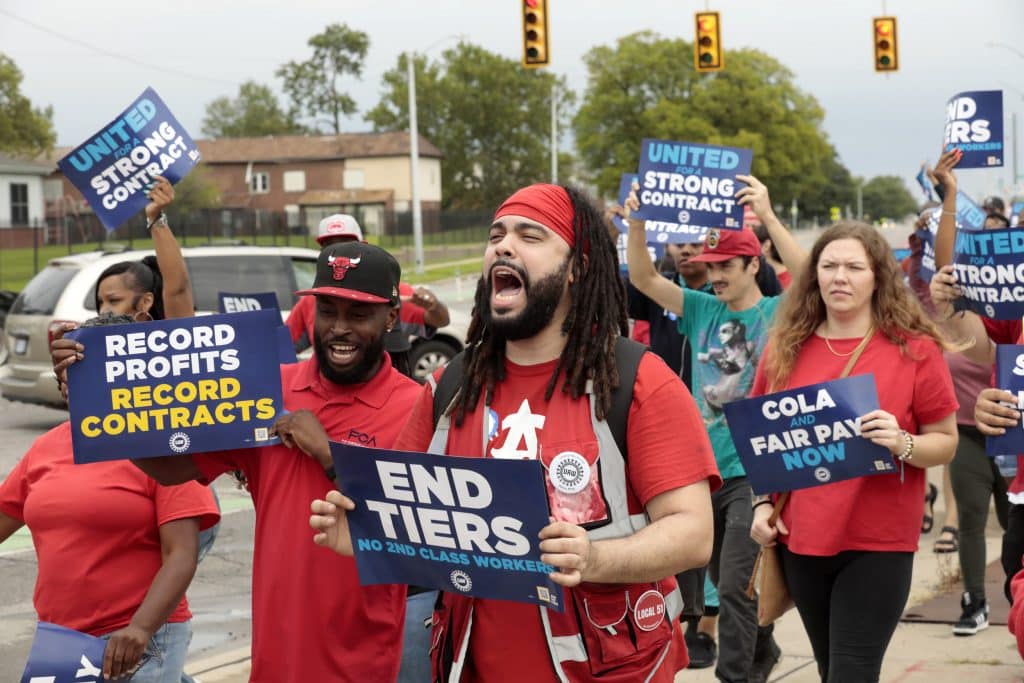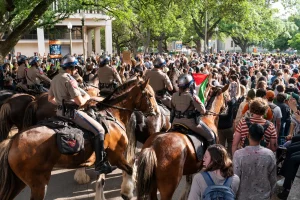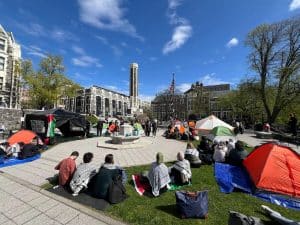On September 15, 2019, close to 50,000 General Motors (GM) workers, represented by the United Auto Workers (UAW) union, went on a national strike that lasted for more than six weeks. That action, the first U.S. automotive workers strike in more than a decade, led to significant gains for some GM employees, including 14 percent wage increases over the four years of the contract and a faster path to top wages for new workers. But the UAW agreement also allowed for the closure of three plants, resulting in layoffs of more than 14,000 UAW members, and all of the wage gains won in that contract have since been eaten away by rising costs for essentials, including food, housing, and gasoline.
Now, just four years later, after a devastating pandemic and two years of skyrocketing inflation, UAW members have overwhelmingly approved yet another strike authorization, this time in negotiations with the Big Three automakers: Ford, GM, and Stellantis. And with ambitious demands for shorter work weeks, improved pensions, and a 46 percent wage increase on the table — not to mention demands to end the hated multi-tier wage system and outsourcing of electric vehicle production — there is a very real chance that we could see another major auto workers strike this month. Indeed, the union has already rejected offers from all of the Big Three automakers, called Ford’s latest offer insulting, and filed unfair labor practice grievances against Stellantis and GM for not bargaining in good faith.
While it is easy to view this latest strike authorization vote and heated rhetoric as merely performative — part of the usual contract negotiations designed to improve leverage at the bargaining table — there is nothing usual about the context in which this latest contract struggle is unfolding. With more than 160,000 writers and actors still on the picket lines, and strike threats spreading throughout several sectors of the economy, a strike at the Big Three (which employs more than 150,000 UAW workers) could offer an enormous boost to the burgeoning new labor movement underway in the United States. Understanding the importance of this context and learning from the mistakes of the 2019 strike — as well as the UPS contract struggle — is an essential part of building the momentum needed to expand rank-and-file workers’ power and democracy in the UAW and across the country.
A New Labor Movement on the Rise
Looking back, it’s clear that the 2019 strike at General Motors was far from perfect for a whole host of reasons. Though GM workers had received wide support and solidarity from other auto workers across the country and the world, there were no attempts to spread the strikes or picket actions to other sectors of the industry, a move that would have put enormous pressure on GM, which was already losing millions of dollars a day. Meanwhile, the UAW had saved up hundreds of millions of dollars in strike funds going into that struggle — enough to provide every worker with $500 a week for at least three months. But the union was providing just $250 a week to striking workers, far less than what was needed to keep them above water during a long strike. Because of the weakness of rank-and-file organization within the UAW, this allowed the union bureaucracy, which was already neck-deep in a federal corruption investigation, to sell the workers a weak contract, which included massive layoffs and an increase in the use of hyper-exploited part time workers. By buying out desperate workers with large signing bonuses in place of the real demands for no layoffs, increased wages, and eliminating the two-tier system, the bureaucracy was able to end the strike and call it a victory.
Despite these many missteps and betrayals, the 2019 strike nonetheless marked a meaningful shift toward a more combative posture for the UAW and was an important part of a broader movement in U.S. labor as a whole. After 11 years of givebacks by the UAW in a misguided effort to shore up automakers’ balance sheets during the great recession, the union had finally decided to stand its ground against further cuts to the welfare and wages of its members. Indeed, the UAW had given so much away over the previous decade that by 2018, GM was not only back in the black, but was reporting record profits of $8 billion — and the UAW wanted its share.
But GM workers were not the only ones fed up with givebacks and cuts. That same year 200,000 public school teachers went on strike, following the more than 800,000 who had walked out across the country just the year before, which saw the biggest number of workers on strike in 30 years. Like GM workers, these teachers were pushing back against decades of austerity that, in this case, were devastating public schools as well as destroying their livelihoods. Labor’s fightback against decades of neoliberalism was beginning to take shape and teachers and auto workers were on the front lines.
This burgeoning strike wave was interrupted by the pandemic, as many workers were laid off, while others scrambled to fight for workplace health protections and negotiate rules around remote work. Labor unions were bogged down in the minutiae of these negotiations, and traditional labor leaders, particularly those in the public sector, all too often bought into the rhetoric that we were all in the same boat, choosing to work with state officials to maintain labor peace in hopes of winning small legislative concessions and reforms. While the first year of the pandemic saw a temporary slow down in labor unrest, working people were quietly drawing conclusions. After months of being told they were essential while being treated like they were disposable, workers began to fight back, often by going on strike, walking out in protest, or even walking off the job permanently — as many did in what came to be known as the great resignation. Meanwhile, the experience of the pandemic, as well as the tumultuous Black Lives Matter uprisings of 2020, had helped raise and reignite the class consciousness and the expectations of a whole new generation of workers who went on to organize in places like Amazon, Starbucks, Chipotle, and Trader Joes — places that critics said could never be unionized. This new wave of unionization efforts not only increased the number of new union members in logistics and retail, but has helped to raise the profile of labor in the U.S. more broadly. In 2022, 71 percent of people polled in the United states said they had a favorable view of labor unions, up six points from before the pandemic, and a whopping 23 points since the Great Recession. In fact, union approval rates are higher now than they have been in almost 60 years.
Lessons From the Fight at UPS and the 2019 Strike
This general support for labor was made abundantly clear in the lead-up to what could have been one of the most important actions in recent labor history at UPS. Despite the fact that the union leadership managed to contain a strike, the UPS contract struggle showed that working people are eager and ready to fight: UPS workers voted overwhelmingly in favor of a strike authorization, and thousands participated in practice pickets in the lead up to the July 31 contract deadline. The strike authorization also received wide support from other labor unions, labor activists, and working people across the country, including rail workers and UPS pilots who expressed their solidarity with UPS workers and vowed not to cross the picket lines. Although the strike never manifested, the threat helped the Teamsters to push back against at least some of the givebacks made in previous contracts. Unfortunately, it did little to address the underlying inequality within the ranks of the union, where largely part-time warehouse employees continue to be paid a fraction of what delivery drivers make. This is just another reason why fighting to eliminate tiers is central to building strong and unified unions. Nonetheless, for many workers at UPS and those who were closely following the negotiations, the lessons are clear: when you fight you can win, and when you fight harder, you can win more.
And UAW members and leaders have been paying attention and drawing conclusions from that struggle as well. Among these is the UAW’s new president, the down-to-earth and tough-talking Shawn Fain, who took over the union earlier this year in the first direct election of a UAW leadership in the union’s history. For Fain, who attended UPS Teamsters rallies in July, and who has been pointing to the Teamsters as a model for UAW contract negotiations for months, the connections between the UPS struggle and the UAW struggle run deep.
Like the Teamsters, who battled to end tiers for delivery drivers, UAW seems determined to end the use of hyper-exploited part-time workers, who earn only about half of what full timers make, as well as the entire multi-tier system of wages it negotiated in 2007, in which second-tier new hires sometimes earn starting wages that are far less than what first-tier workers earn. This has left many UAW members with subsistence-level pay, pitted full-time and temporary workers against each other, and undermined union solidarity. The Teamsters’ failure to adequately address the problem of tiers at UPS should be a lesson to Fain and the UAW. While companies like UPS, Ford, and GM may be willing to temporarily eliminate or close the gap between different tiers — often in exchange for major givebacks elsewhere — these companies make massive profits off of the continued exploitation of lower-paid and part-time workers. Actually ending once and for all the inequality between tiers will require nothing less than an open-ended strike at all three auto manufacturers.
At the same time, the UAW is fighting for higher wages amid record-breaking profits. Just like UPS, the Big Three have seen incredible profits over the last decade, including $21 billion in just the first six months of this year. While UPS’s windfall allowed Teamsters to win some small wage gains and to push back against the abysmally low wages for many warehouse workers, they still failed to secure the $25 an hour warehouse workers said they were willing to strike over. If the UAW is serious about winning anything close to the unprecedented 46 percent wage increases they are demanding, they will have to learn from the failures of the 2019 strike and make sure that they mobilize not only every worker at the Big Three (full-time, part-time, and temporary), but as many UAW workers at other plants and distribution centers around the world as possible.
Because auto production remains a globalized industry, and because companies like GM and Ford have months’ worth of reserve products, a strike in this or that single country only shuts down part of the production process. In other words, real power requires global working-class solidarity and coordination. And this is looking increasingly possible this time around. In what could turn out to be a remarkably fortuitous development, 11,000 Canadian auto workers, represented by Unifor, have also held a successful strike authorization vote in their own negotiations with the Big Three, and their contract expires just three days after the UAW contract. Coordinating with Unifor, standing in solidarity with them, vowing to respect each other’s pickets regardless of the state of their own negotiations, and striking together will be essential for winning the greatest share possible of the massive wealth that Ford, GM, and Stellantis have been raking in in the wake of the pandemic, profits that have been generated by the workers that make those vehicles.
As Fain told his members in a Facebook Live event on August 15, in which he announced plans for the strike authorization vote, the Big Three have:
…collectively made a quarter of a trillion dollars in North American profits over the last decade, but instead of investing that profit in us, the workers who made it, they’ve squandered it on giveaways to the rich investors and the CEOs. In the last four years, the Big Three spent about 16 billion collectively on special dividends, stock buybacks, and supercharged CEO salaries.That’s billions of dollars lavished on shareholders and executives rather than the workers who make these companies run.
In that same speech, Fain went on to talk about how companies like GM socialize losses and privatize profits, described what he called a one-sided class war against auto workers, vowed to end the tier system across the Big Three, and called on UAW members to support auto workers in Silao, Mexico who, despite their harsh working conditions and low pay, vowed not to take overtime in solidarity with GM workers during the 2019 strike.
The New Reform Bureaucracy
This is not the kind of rhetoric one expects from the leader of a historically chauvinistic business union like the UAW. Indeed, Fain at times sounds more like an activist than a union president, and he is not alone. Like the Teamsters’ new leader Sean O’Brien and the Association of Flight Attendants’ Sara Nelson, Fain is the latest iteration of a new reform bureaucracy that has slowly gained a foothold in major unions like the Teamsters and the UAW over the last several years. Neither especially radical nor conservative, these new bureaucrats have managed to repackage themselves as “progressive” fighters for workers’ rights, taking stands against state policy on immigration law, as Sara Nelson did in 2017, leading high-profile contract struggles, like O’Brien and Fain, and helming major public sector strikes like the former UTLA Union president Alex Caputo-Pearl did in 2019.
However, despite the tough talk and the occasionally progressive stand on this or that social issue, these new labor leaders remain tied to the state and the Democratic Party in particular. They continue to oversee and lead unions whose central task remains building relationships with, lobbying, and endorsing Democratic Party members and candidates in the paradoxical belief that they can use the Democrats — enemies of the working class — to pass legislative reforms that might be good for labor. This is evidenced by the close ties these leaders maintain with the state: Sara Nelson, despite her reputation as a leader willing to take on the POTUS, was a serious recent contender for Secretary of Labor, and Sean O’Brien, despite his tough talk about leading a strike at UPS, was directly involved in backroom negotiations with former Labor Secretary Marty walsh and President Biden that helped successfully avoid a rail strike last year.
Fain, like O’Brien, comes from the bureaucracy of the UAW leadership apparatus, but unlike O’Brien, who received the endorsement of the reform caucus Teamsters for a Democratic Union (TDU), Fain was a member of the reform caucus (Unite All Workers for Democracy) that brought him to power on a platform of “no corruption, no concessions, no tiers.” In other words, Fain is not merely supported by reformists in his union — he is one of them.
What this will mean for the current negotiations and Fain’s willingness to lead an open-ended strike against the Big Three, not to mention the broader, much needed democratic reform within the UAW, remains to be seen. His connections to UAW Members United could put pressure on him to meet those demands and to push for more reforms; however, it could also lead to compromise. Let’s remember, Fain and his caucus narrowly won in the last election, and the still powerful influence of the old guard Administration Caucus will exert a conservative pressure in these contract negotiations. Regardless of how he came to power, however, Fain, like other UAW leaders, is still committed to working with the Democratic Party (as his appearances with Senator Bernie Sanders make clear), and still constrained by the larger structure of the UAW, which, like so many business unions, is committed to a top-down organizing strategy grounded in the use of massive armies of paid organizers and staffers, a structure that leaves little room or resources for true rank-and-file democracy and organization.
There Is No Substitute for Rank and File Power
While Fain’s combativeness and rhetoric may be injecting some much needed militancy within the ranks of the union and among some of the workers on the shop floor, charismatic leadership is no substitute for rank-and-file organizing. If the workers at UAW wish to win the gains they are demanding (and so justly deserve) and build the kind of real power necessary to force the Big Three to make concessions, they will have to do more than merely follow their elected leaders. True union power comes from the shop floor in the form of active solidarity, democratic debate, discussion, and decision-making processes that involve all of the workers at a plant or shop. This includes intense debate and discussion of demands, of proposed contract agreements, of when and how to strike, and of whether or when to end a strike. Rank-and-file power also has to include the right to open, transparent bargaining so that workers know where negotiations stand, and the power to recall their leaders at any time for any reason.
Such organization, however, has to be about more than just contracts, wage gains, benefits, or working conditions, which are fought for every four years and then ignored until the next contract is close to expiring. Independent rank-and-file organizing puts the power of the workplace into the workers’ hands. And this is what the bosses, the politicians, and the bureaucrats fear more than anything else. An empowered rank and file, one capable of acting democratically and independently of the union bureaucracy and its apparatuses, one capable of forcing the leadership to put the resources of the union at the disposal of the workers themselves and their communities, can achieve almost anything. Whether it’s fighting against plant closures, fighting the Far Right, fighting for universal health care and free college tuition, or fighting to defend abortion rights and protecting trans people from violence and state oppression, an organized, politicized, and engaged working class can collectively use the power of its labor to win all the things the Democrats pretend to fight for and much more.
But such actions also require political independence. The U.S. working class, including auto workers, must shuck off the influence of the Democrats and the Republicans, both of which work for the bosses. Neither Trump nor Biden are friends of labor and the working class. In fact, they and their parties are the ones who defend the very system that leads to plant closures, stagnant wages, union busting, and low unionization rates. They are the ones who support wasteful billions of dollars in military spending — whether it goes to Ukraine or to the U.S. armed forces — while defending the continued privatization of increasingly unaffordable essentials like health care, housing, energy, transportation, and education. A truly independent working class needs an independent working-class party capable of coordinating struggles across regions and sectors, one that fights for socialism and the liberation of all people from exploitation and oppression.
A strike by UAW workers at the Big Three, joined by actors, writers, and flight attendants, would simultaneously organize and radicalize hundreds of thousands of workers, revealing their power and raising their expectations in ways that could have a massively outsized positive influence on the future of labor in the United States. Every worker should support the UAW’s struggle and work to build the institutions in their own unions to stand in solidarity with them when they strike and to lay the ground for the future independent political power of the working class as whole.











